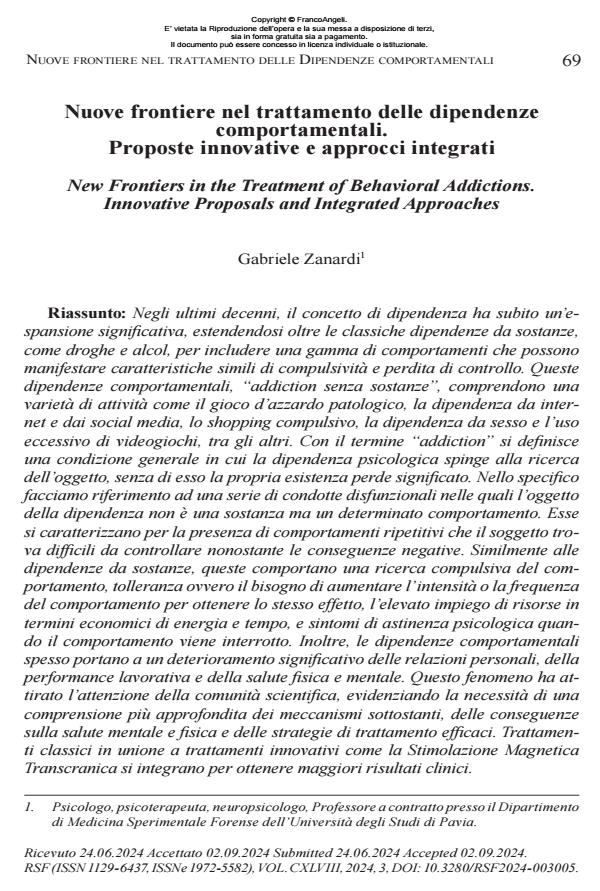Nuove frontiere nel trattamento delle dipendenze comportamentali. Proposte innovative e approcci integrati
Titolo Rivista RIVISTA SPERIMENTALE DI FRENIATRIA
Autori/Curatori Gabriele Zanardi
Anno di pubblicazione 2024 Fascicolo 2024/3
Lingua Italiano Numero pagine 12 P. 69-80 Dimensione file 714 KB
DOI 10.3280/RSF2024-003005
Il DOI è il codice a barre della proprietà intellettuale: per saperne di più
clicca qui
Qui sotto puoi vedere in anteprima la prima pagina di questo articolo.
Se questo articolo ti interessa, lo puoi acquistare (e scaricare in formato pdf) seguendo le facili indicazioni per acquistare il download credit. Acquista Download Credits per scaricare questo Articolo in formato PDF

FrancoAngeli è membro della Publishers International Linking Association, Inc (PILA)associazione indipendente e non profit per facilitare (attraverso i servizi tecnologici implementati da CrossRef.org) l’accesso degli studiosi ai contenuti digitali nelle pubblicazioni professionali e scientifiche
Negli ultimi decenni, il concetto di dipendenza ha subito un’e- spansione significativa, estendendosi oltre le classiche dipendenze da sostanze, come droghe e alcol, per includere una gamma di comportamenti che possono manifestare caratteristiche simili di compulsività e perdita di controllo. Queste dipendenze comportamentali, “addiction senza sostanze”, comprendono una varietà di attività come il gioco d’azzardo patologico, la dipendenza da inter- net e dai social media, lo shopping compulsivo, la dipendenza da sesso e l’uso eccessivo di videogiochi, tra gli altri. Con il termine “addiction” si definisce una condizione generale in cui la dipendenza psicologica spinge alla ricerca dell’oggetto, senza di esso la propria esistenza perde significato. Nello specifico facciamo riferimento ad una serie di condotte disfunzionali nelle quali l’oggetto della dipendenza non è una sostanza ma un determinato comportamento. Esse si caratterizzano per la presenza di comportamenti ripetitivi che il soggetto tro- va difficili da controllare nonostante le conseguenze negative. Similmente alle dipendenze da sostanze, queste comportano una ricerca compulsiva del com- portamento, tolleranza ovvero il bisogno di aumentare l’intensità o la frequenza del comportamento per ottenere lo stesso effetto, l’elevato impiego di risorse in termini economici di energia e tempo, e sintomi di astinenza psicologica quan- do il comportamento viene interrotto. Inoltre, le dipendenze comportamentali spesso portano a un deterioramento significativo delle relazioni personali, della performance lavorativa e della salute fisica e mentale. Questo fenomeno ha at- tirato l’attenzione della comunità scientifica, evidenziando la necessità di una comprensione più approfondita dei meccanismi sottostanti, delle conseguenze sulla salute mentale e fisica e delle strategie di trattamento efficaci. Trattamen- ti classici in unione a trattamenti innovativi come la Stimolazione Magnetica Transcranica si integrano per ottenere maggiori risultati clinici.
Parole chiave:Dipendenze Comportamentali, Gioco d’Azzardo Patolo- gico, Compulsività, Sistema di Ricompensa, Stimolazione Magnetica Tran- scranica.
Gabriele Zanardi, Nuove frontiere nel trattamento delle dipendenze comportamentali. Proposte innovative e approcci integrati in "RIVISTA SPERIMENTALE DI FRENIATRIA" 3/2024, pp 69-80, DOI: 10.3280/RSF2024-003005